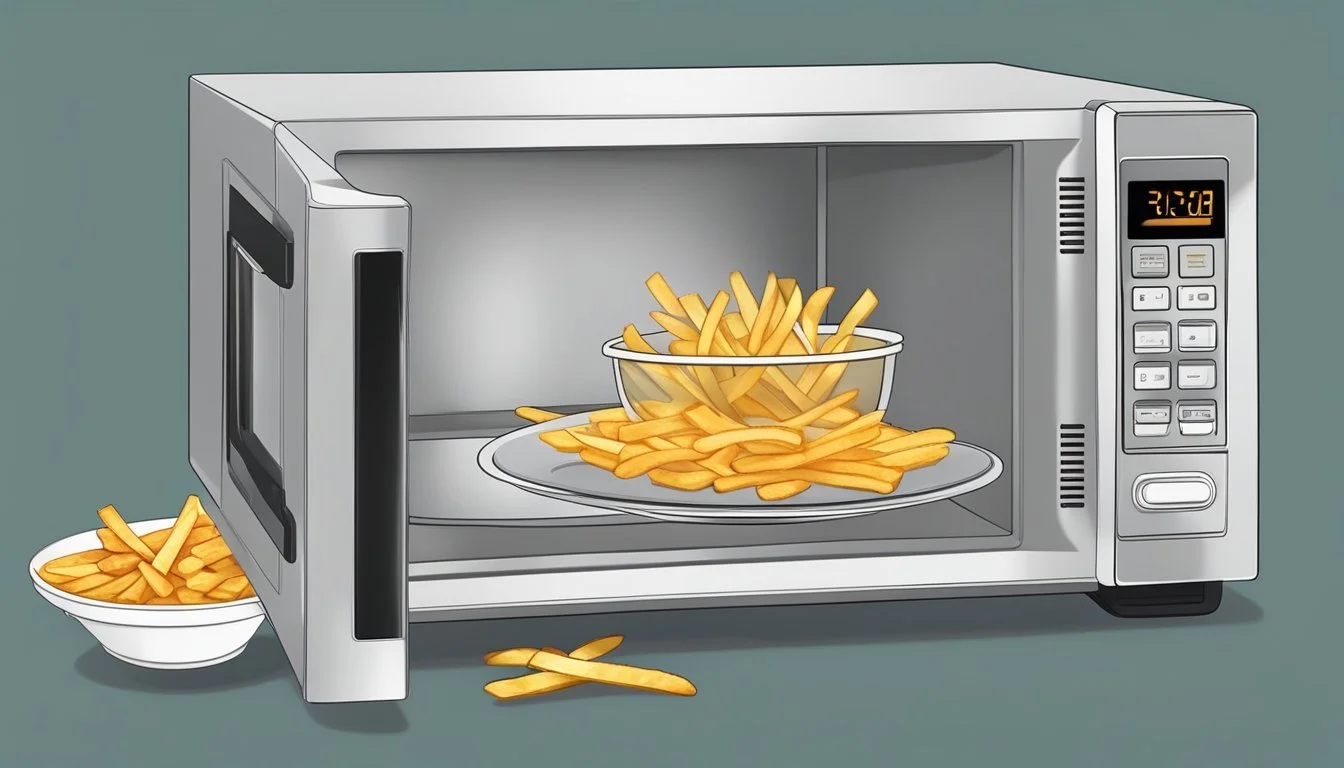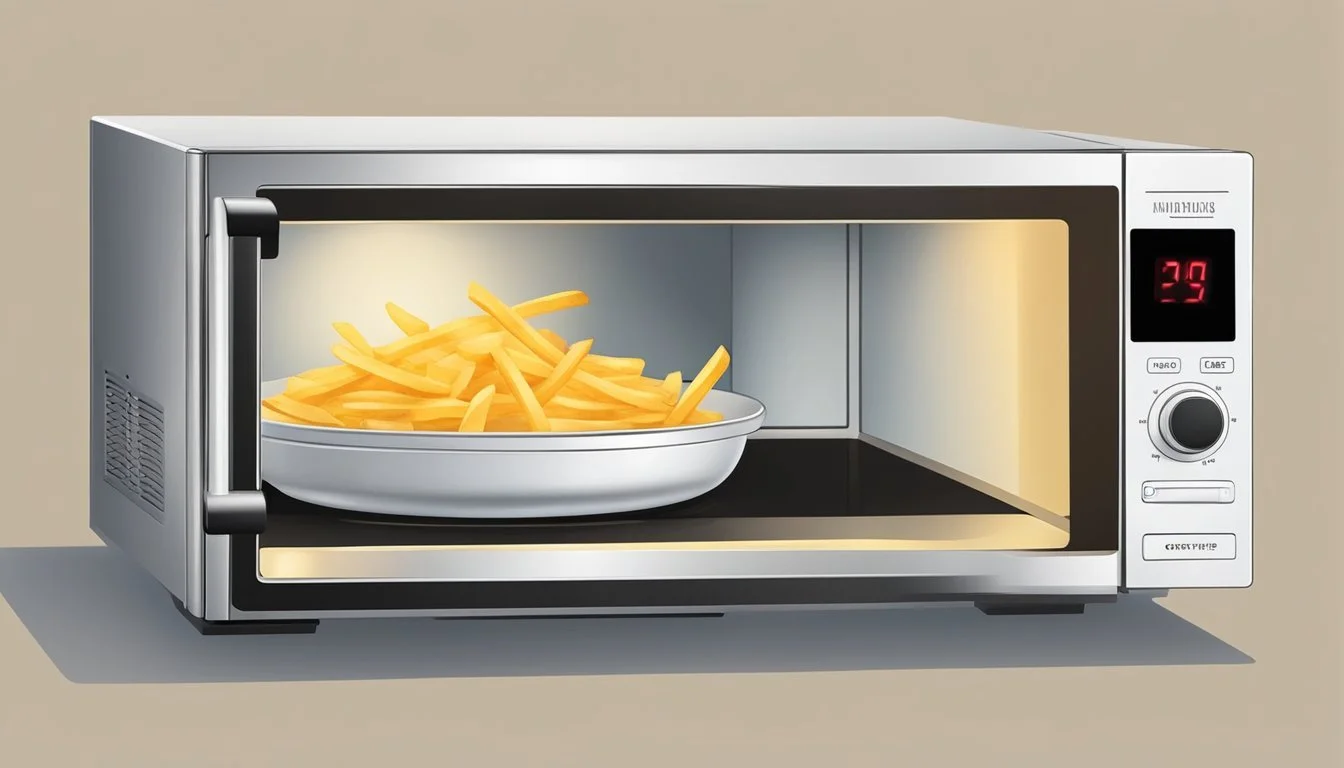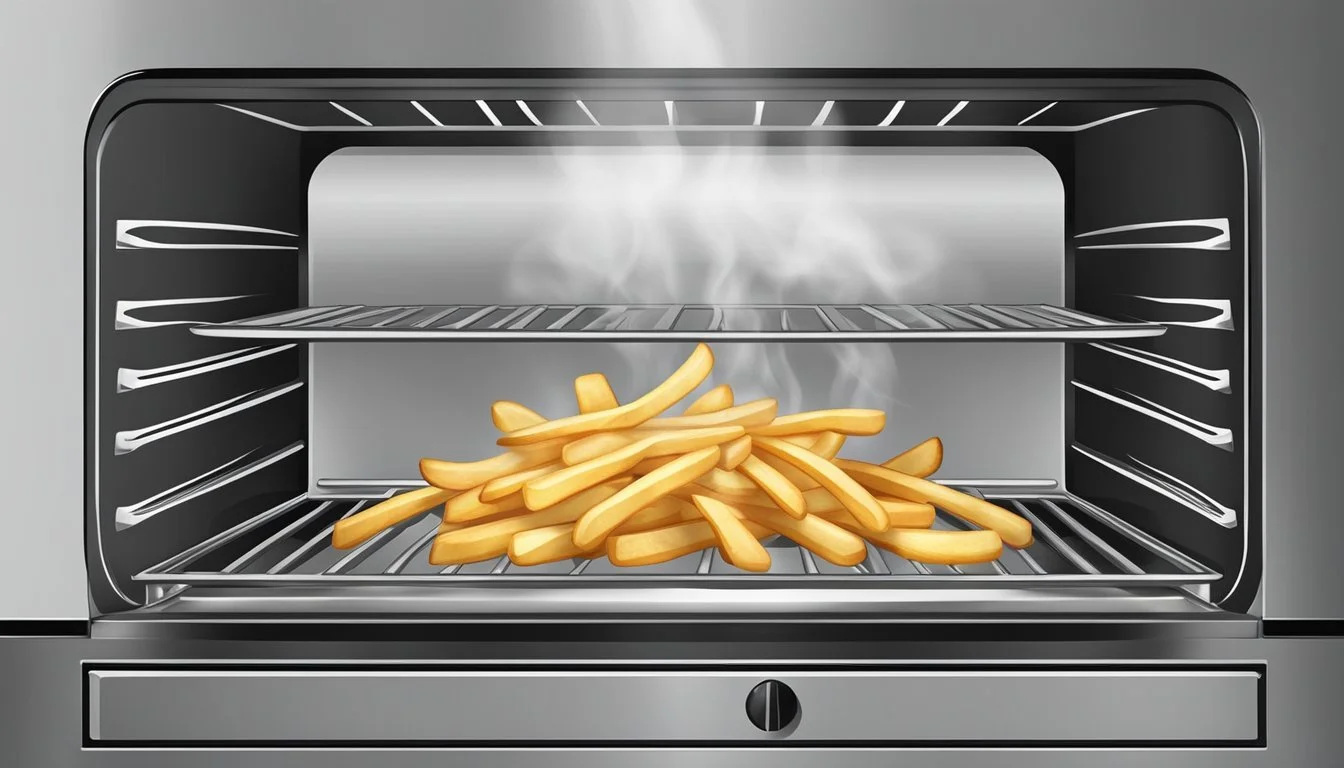How to Reheat Gluten-Free French Fries for Optimal Taste and Texture
Reheating gluten-free French fries can be a challenge, but with the right approach, they can be just as delicious as when freshly made. The key to success lies in using an oven to achieve that perfect crispy texture. By spreading the fries out on a parchment-lined baking sheet and baking them at 425 degrees Fahrenheit, you ensure they heat evenly without getting soggy.
Another effective method is using an air fryer, which provides a quick and easy way to reheat gluten-free fries. Simply place them in the air fryer basket and cook for a few minutes until they’re hot and crispy again. This technique also helps maintain the fries' original flavor and texture.
For those preferring a stovetop approach, heating a bit of vegetable or peanut oil in a heavy-bottom pan can work wonders. Fry the leftover fries for a few minutes until they regain their crispness. Each of these methods ensures that gluten-free French fries can be enjoyed as a tasty snack or side dish, even after they've been refrigerated.
Understanding Gluten-Free French Fries
Gluten-free French fries not only cater to those with gluten sensitivities but also offer nutritional benefits. Selecting the appropriate type of potatoes and understanding the nutritional aspects can help in making the best gluten-free fries.
Nutritional Profile of Gluten-Free Fries
Gluten-free French fries made from pure, unseasoned potatoes are naturally free from gluten.
They provide essential nutrients such as potassium, which supports heart and muscle functions, and vitamin C, an antioxidant crucial for skin health and immune function.
Additionally, they are a source of dietary fiber, aiding in digestion, and iron, which helps in the transportation of oxygen in the blood.
However, the method of cooking can impact their nutritional value. Frying increases the amount of extra oil and calories, so baking may be a healthier option. Understanding this balance is essential for making healthier gluten-free fries at home or when choosing from a menu.
Choosing the Right Potatoes for Gluten-Free Fries
Selecting the right potatoes is key to achieving crispy fries that are gluten-free.
Russet potatoes are a popular choice due to their high starch content, which helps in achieving a crispy texture.
Yukon Gold potatoes also work well and provide a creamy interior when fried or baked. In terms of nutritional value, both types offer calcium, which is important for bone health.
It's crucial to use potatoes that are fresh and free from any residues of gluten-containing substances. Ensuring that the cooking environment and utensils are free from contamination is also important to maintain the gluten-free status of the fries.
By focusing on these aspects, one can enjoy delicious and safe gluten-free French fries.
Preparation for Reheating
Reheating gluten-free fries involves ensuring that they maintain their crispiness and flavor. Proper preheating of your appliance and handling your leftover fries are crucial steps.
Preheating Your Appliance
Begin by setting your appliance to the appropriate temperature. For an oven, preheat to 425 degrees Fahrenheit. This high temperature helps achieve a crispy exterior without drying out the fries.
Toaster ovens are another effective choice, requiring a similar temperature range (425–450 degrees). Place a baking sheet inside while preheating to warm it up, which facilitates even cooking.
For an air fryer, preheat to 350 degrees for a crisp yet tender result. The shorter cook time (3-5 minutes) makes it an efficient option.
Consistent preheating helps the fries to reheat evenly, ensuring a uniform texture and flavor.
Storing and Handling Leftover Fries
When storing leftover fries, place them in an airtight container to maintain their freshness. Refrigerate them promptly to prevent bacteria growth and maintain their texture.
Avoid overcrowding the fries in the container. Overcrowding can lead to unwanted moisture buildup, making reheating less effective.
Before reheating, spread the fries out on a baking sheet or skillet in a single layer. This will ensure each fry gets adequately reheated and retains its crispy texture.
Gently toss the fries occasionally during reheating to promote even cooking and avoid sogginess. Ensuring they don’t touch will help each fry recover its crispy exterior.
Reheating Techniques
Whether using an oven, air fryer, or skillet, these methods ensure that gluten-free French fries come out crispy and golden brown. Each method has its unique advantages based on the equipment and desired results.
Using an Oven for Best Results
Preheat the oven to 425°F (220°C). Line a baking sheet with parchment paper to prevent sticking. Spread the leftover fries in a single layer, making sure they don’t touch each other. This helps them stay crispy. Bake for 8-10 minutes, then turn them over to ensure even crisping. For extra crispiness, continue baking for a few more minutes.
A convection oven can enhance results by circulating hot air and reducing cook time. A higher temperature blast at the end can help achieve a golden brown finish. Avoid overcrowding the baking sheet as this traps steam, making fries soggy rather than crispy.
Air Fryer Method for Crispiness
Preheat the air fryer to 400°F (200°C). Place the fries in the basket in a single layer. If needed, cook in batches to avoid overcrowding. Air fry for about 6-8 minutes, shaking the basket halfway through to ensure even cooking.
The air fryer method is popular for reheating fries because it uses circulating hot air, which mimics deep frying but with very little oil. This results in fries that are crispy on the outside and fluffy on the inside. It is a quick and efficient way to bring life back to gluten-free fries without using additional fat.
Skillet Method for Small Batches
Heat a skillet over medium-high heat and add a few tablespoons of oil with a high smoke point, such as vegetable or peanut oil. Once the oil is shimmering, add the fries in a single layer. Cook for 3-5 minutes, turning them occasionally to ensure they fry evenly and become crispy.
This method is ideal for smaller batches and offers precise control over texture and color. The key is to maintain a hot skillet and avoid overcrowding it. Alternatively, a cast-iron skillet can be used for better heat retention, which aids in achieving a crisp finish. Be mindful of oil splatters and adjust the heat as needed to prevent burning.
Each method provides a unique way to reheat gluten-free French fries, ensuring they remain delicious, crispy, and golden brown.
Tips for the Perfect Reheat
Reheating gluten-free French fries requires careful attention to avoid sogginess, achieve even cooking, and enhance their flavor. These tips will help ensure your fries come out crispy and delicious every time.
Avoiding Sogginess
To avoid sogginess, reheating fries in a single layer is crucial. Overcrowding the fries in the pan or tray can trap steam and prevent them from becoming crispy.
Using a baking sheet or an air fryer basket ensures that the fries are spaced out evenly. Cooking spray can provide a light coating to help achieve the crispy exterior. Incorporating an oven temperature around 425 degrees Fahrenheit typically yields the best result.
Achieving Even Cooking
Achieving even cooking means giving attention to both the heat and the placement of the fries. Preheating a skillet or oven ensures that the fries start crisping as soon as they’re added.
Flipping the fries halfway through the reheating process helps attain even browning. Using a little extra oil, particularly oils with a high smoke point like vegetable oil, can also facilitate even cooking, making the fries golden brown and crispy on all sides.
Enhancing Flavor Post-Reheat
Enhancing the flavor of gluten-free fries post-reheat involves strategic seasoning. After reheating, immediately sprinkle salt or other desired seasonings to help them stick to the hot fries.
Using freshly chopped herbs like parsley or dill can add a refreshing taste. Another option is to add a sprinkle of parmesan cheese for a savory twist. For those who want a touch more flavor, truffle oil drizzled over the hot fries can elevate their taste significantly.
By following these tips, reheating gluten-free French fries can be a straightforward process resulting in fries that are just as delightful as when first cooked.
Seasonings and Accompaniments
Highlighting the perfect seasonings and accompaniments can elevate your reheated gluten-free French fries to new heights. Explore classic seasonings, and discover delicious pairings to enhance your fries.
Classic Seasonings for French Fries
Gluten-free French fries can be wonderfully versatile when it comes to seasonings. Sea salt remains a staple, adding a touch of simple yet essential flavor. For an added kick, many enjoy garlic powder or onion powder sprinkled lightly over the fries.
A dash of paprika can introduce a smoky flavor, while seasoned salt provides a robust taste profile. Shredded Parmesan or even a mix of Italian herbs can add a gourmet twist. Each of these options can be used individually or combined to create a personal seasoning blend.
Pairings with Reheated Gluten-Free French Fries
Several accompaniments can perfectly complement and enhance the taste of reheated gluten-free French fries. Ketchup is a classic choice, offering a tangy contrast to the crispy fries. Mayonnaise can be mixed with spices to create a richer dipping sauce.
Cheese dips, particularly those containing cheddar or blue cheese, provide a creamy texture alongside the crispy exterior of the fries. For a zesty option, try salsa or a spicy aioli. These pairings not only add flavor but also texture, creating a satisfying experience with every bite.
Alternative Gluten-Free Varieties
When exploring gluten-free French fries, it's essential to consider other vegetable fries and different cuts and shapes. These alternatives offer various flavors and textures suitable for different palate preferences.
Sweet Potato and Other Vegetable Fries
Sweet potato fries provide a nutritious twist on the classic potato fry. Rich in vitamins A and C, sweet potatoes are a popular gluten-free choice. They can be baked or fried, producing a sweet and savory flavor.
Other options include fries made from zucchini or carrots, which offer a unique taste and are perfect for a vegetarian diet. These fries can be coated with gluten-free breadcrumbs for added crunch.
Many of these alternative fries can be found frozen, making them convenient and quick to prepare. They can be warmed up in an oven or air fryer for a crispy texture.
Exploring Different Cuts and Shapes
Different cuts and shapes can enhance the eating experience of gluten-free fries. Thin fries offer a classic, crispy texture, while waffle fries provide a hearty bite with a unique shape.
Potato wedges are thicker and often seasoned, making them a flavorful option. Mozzarella sticks, while not a traditional fry, are a tasty gluten-free side that complements many meals.
These varieties can be reheated using an oven or air fryer, ensuring they remain crispy and delicious. Reheating times may vary based on the cut and thickness of the fries.
Avoiding Food Waste
Reheating gluten-free French fries can be an excellent way to reduce food waste. Properly storing leftovers ensures they stay fresh longer, and creativity in their reuse can breathe new life into them.
Storing Leftovers Properly
Proper storage begins with cooling the leftover fries to room temperature. Then, place leftover fries in an airtight container. Glass containers with tight lids work well, as they prevent moisture loss and avoid fridge odors. It's crucial to refrigerate the fries promptly, ideally within two hours to maintain their quality and safety.
When storing, separate the fries into smaller portions. Doing so makes reheating easier and more efficient. Consider using parchment paper layers between portions to keep them from sticking together. Adding a light mist of extra oil before sealing can help maintain their crispy texture during storage.
Creative Uses for Reheated Fries
There's no need for leftover fries to be boring. Reheated fries can be transformed into numerous dishes that reduce food waste creatively. One interesting option is to chop the reheated fries and use them as a topping for salads. The crispy texture adds a delightful crunch.
Another way to repurpose them is by creating a breakfast hash. Combine the fries with scrambled eggs, diced vegetables, and a dash of salt for a hearty and delicious meal. Fries can also be used as a base for nachos. Just add cheese, salsa, and other toppings, then bake until everything is heated thoroughly.
Using reheated fries innovatively not only tackles food waste but also allows for diverse and satisfying meals.






